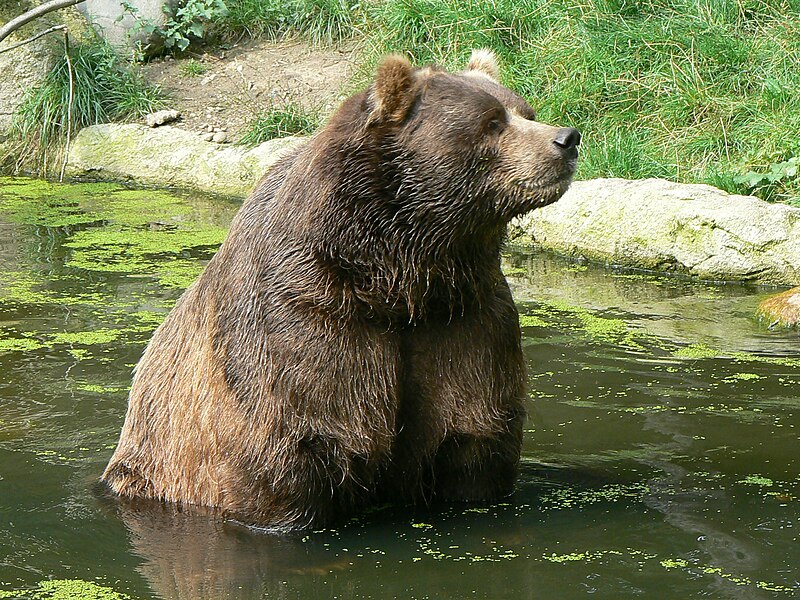Ursus Arctos Middendorffi Facts for Kids
The Kodiak bear is a large subspecies of brown bear found in the Kodiak Archipelago of Alaska, known for its impressive size and role in the ecosystem.
View Article For:

Related Articles
Introduction
They are one of the largest bear species in the world! Kodiak bears can weigh between 600 to 1,500 pounds (272 to 680 kg) and stand up to 10 feet tall when on their hind legs! These bears have thick, dark brown fur that helps keep them warm in cold weather. They are known for their big claws and strong bodies, making them excellent at fishing for salmon in rivers. 🐟
Let's learn more about these amazing animals!
Habitat And Range
️ They enjoy habitats like coastal areas, forests, and mountains. Kodiak Island is known for its beautiful views and lots of food sources, making it a great home for these bears! Kodiak bears like to be near rivers and streams where they can catch fish, especially salmon. 🐟
These bears spend most of their time on land but are also great swimmers!
Conservation Status
The Kodiak Archipelago is protected, which helps keep bears safe from hunting and habitat loss. However, they still face threats like climate change and human disruption. We must protect their environment to ensure Kodiak bears remain healthy and continue to roam Alaska's forests and rivers for years to come! 🌲
Research And Studies
🔬 Researchers use radio collars and cameras to track their movements and understand their needs better. Various studies have found that Kodiak bears need large territories to find food and grow healthy. 🏞
️ Understanding these bears helps conservation efforts, ensuring they can thrive in their natural habitat. With ongoing research, we can share more knowledge about Kodiak bears with everyone! 📚
Cultural Significance
They are often featured in stories, legends, and artwork. The Kodiak bear symbolizes strength and survival, showing the connection between humans and nature. Some tribes honor bears with special ceremonies and use bear fur and bones for various crafts. Kodiak bears are part of Alaska's identity and remind everyone of the wild beauty present in our world. 🐻✨
Diet And Feeding Habits
They love munching on berries, grasses, and roots in the summer. When salmon is spawning (that's when they swim upstream to lay eggs), Kodiak bears try to catch them! 🐟
They can eat up to 100 pounds of fish in just one day! Kodiak bears also search for clams and sea urchins on the beach. In the fall, they eat a lot to prepare for winter hibernation, gaining weight before sleeping for months! 🌭
Interactions With Humans
️ People live nearby but must be cautious when exploring bear territory. Many tourists visit Kodiak Island to see these magnificent creatures from a distance. Some local communities engage in bear watching! 🐻
However, people must remember not to feed them, as it can cause problems. When bears get used to humans, it can be dangerous for both bears and people. Let's respect their space! 🌲
Physical Characteristics
❄️ Their fur is brown and can be light or dark, depending on the season. Adult males can weigh up to 1,500 pounds, while females usually weigh around 700 pounds. They have strong, long legs for running fast or climbing. Kodiak bears have large paws that measure about 12 inches wide! Their claws are sharp and can be up to 4 inches long. With such big bodies, they need a lot of food and can eat different kinds of food, including plants, berries, and fish. 🌿🍓
Reproduction And Lifespan
The cubs are tiny and weigh just a pound at birth! They're covered in soft fur and stay with their mother for about 2-3 years, learning important survival skills. Kodiak bears can live up to 25 years in the wild! With good care, some are known to live even longer in captivity. 🎉
Adaptations To Environment
Their thick fur keeps them warm during the cold winters of Alaska. They have a special layer of fat beneath their skin that provides insulation and energy during hibernation. Kodiak bears can also climb trees with their strong claws if they need to escape danger. 🐻
🏔️ Their excellent sense of smell helps them find food from miles away! All of these traits make Kodiak bears perfect for living in challenging environments like Alaska's wilderness.
Behavior And Social Structure
However, during summer meals, they can be seen together at fish-filled rivers! Males are generally larger and more aggressive than females. Kodiak bears communicate through growls, grunts, and body language. 🐻
They use their strong sense of smell to find food and sense danger. These bears are very protective of their cubs and will fiercely defend them from threats.
DIY is a humongous library of
activities and courses for kids.
Curious?
Gallery of
Did you know?
🐻 Kodiak bears can weigh between 600 to 1,500 pounds, making them one of the largest bear species!
🏔️ They can stand up to 10 feet tall on their hind legs, which is about as tall as a basketball hoop!
🐟 Kodiak bears are great fishermen and can catch up to 100 pounds of salmon in just one day!
🌿 These bears are omnivores, meaning they eat both plants and animals, including berries and fish.
🌍 The Kodiak bear population is stable and considered a species of least concern.
🐻❄️ Kodiak bears have thick, dark brown fur that helps keep them warm in cold weather.
🍼 Female Kodiak bears give birth to 1 to 4 cubs while hibernating, usually in January or February.
🌲 They can live up to 25 years in the wild and even longer in captivity!
🏝️ Kodiak bears primarily inhabit the Kodiak Archipelago, which is a group of islands in Alaska.
🎉 Kodiak bears communicate through growls and body language, and they are very protective of their cubs!










